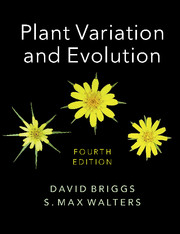Book contents
- Frontmatter
- Contents
- Preface to the Fourth Edition
- Acknowledgements
- Note on names of plants
- List of abbreviations
- 1 Investigating plant variation and evolution
- 2 From Ray to Darwin
- 3 Early work on biometry
- 4 Early work on the basis of individual variation
- 5 Post-Darwinian ideas about evolution
- 6 DNA: towards an understanding of heredity and molecular evolution
- 7 Breeding systems
- 8 Intraspecific variation and the ecotype concept
- 9 Pattern and process in plant populations
- 10 Pattern and process: factors interacting with natural selection
- 11 Populations: origins and extinctions
- 12 Species and speciation: concepts and models
- 13 Allopatric speciation and hybridisation
- 14 Abrupt speciation
- 15 The species concept
- 16 Flowering plant evolution: advances, challenges and prospects
- 17 Historical biogeography
- 18 The evolutionary impact of human activities
- 19 The taxonomic challenge ahead
- 20 Conservation: from protection to restoration and beyond
- Glossary
- References
- Index
1 - Investigating plant variation and evolution
Published online by Cambridge University Press: 05 June 2016
- Frontmatter
- Contents
- Preface to the Fourth Edition
- Acknowledgements
- Note on names of plants
- List of abbreviations
- 1 Investigating plant variation and evolution
- 2 From Ray to Darwin
- 3 Early work on biometry
- 4 Early work on the basis of individual variation
- 5 Post-Darwinian ideas about evolution
- 6 DNA: towards an understanding of heredity and molecular evolution
- 7 Breeding systems
- 8 Intraspecific variation and the ecotype concept
- 9 Pattern and process in plant populations
- 10 Pattern and process: factors interacting with natural selection
- 11 Populations: origins and extinctions
- 12 Species and speciation: concepts and models
- 13 Allopatric speciation and hybridisation
- 14 Abrupt speciation
- 15 The species concept
- 16 Flowering plant evolution: advances, challenges and prospects
- 17 Historical biogeography
- 18 The evolutionary impact of human activities
- 19 The taxonomic challenge ahead
- 20 Conservation: from protection to restoration and beyond
- Glossary
- References
- Index
Summary
The endless variety of different organisms, in their beauty, complexity and diversity, gives to the biological world a special fascination. Some recognition of these different ‘kinds’ of organisms is a feature of all primitive societies, for the very good reason that humans had to know, and to distinguish, the edible from the poisonous plants, or the harmless from the dangerous animal. There is also a further dimension to the variation pattern. From folk taxonomies, the early product of human societies’ need to understand, describe and use the plants and animals around them, the modern scientific biological classifications we use today have been developed. Different ‘kinds’ of organism are arranged in a hierarchy, each higher group containing one or more members of a lower group. We now distinguish more than a quarter of a million flowering plants, and these are arranged in a hierarchical-nested classification of species in genera, genera in families, families in orders etc.
One of the main issues to be examined in this book concerns the nature of species in this hierarchical system. Anyone familiar with the vegetation of an area, or the plants in a Botanic Garden, has to face a number of questions that have puzzled biologists. Is there any objective way of delimiting species? How can one account for the different degrees of intraspecific variation found in species? Why are certain species clearly distinct, while in other cases we find a galaxy of closely similar species, often difficult to distinguish from each other? Why is it that hybridisation occurs frequently in certain groups of plants and not in others? What is the significance of the hierarchies in classification and what is the origin of these groupings?
Historically, an examination of these questions, as we shall see in Chapter 2, produced a static picture of variation, based on a belief in the fixity of species. The hierarchy of classification reflected the plan of Special Creation. However, since 1859, with the publication of On the Origin of Species, all such studies have been made in the light of Darwin's profound generalisation of evolution by natural selection: populations and species vary in time and space and are part of a continuing process of evolution.
- Type
- Chapter
- Information
- Plant Variation and Evolution , pp. 1 - 3Publisher: Cambridge University PressPrint publication year: 2016
- 2
- Cited by

